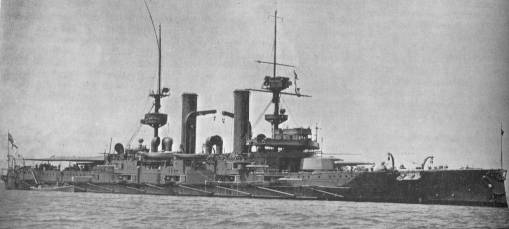These guns were mounted on Coastal Defense vessels intended for the Chilean Navy, Constitution and Libertad. The British took them over in 1906 to prevent their purchase by another European power and renamed them HMS Swiftsure and HMS Triumph, respectively.
The Chileans had chosen this caliber because they were intermediate in size between the standard British mixed secondaries of 6" (15.2 cm) and 9.2" (23.4 cm) guns. Neither the guns nor the mountings on these ships were identical to each other, a somewhat unusual affair in what were supposedly sister-ships. This is explained by the fact that the Mark III was built by Elswick while the Mark IV was manufactured by Vickers.
One of the spare Mark III guns for HMS Swiftsure was used to arm the monitor M.26. In 1917, Swiftsure was decommissioned and two of her guns were then used to arm M.21 and M.23 while the other twelve were used for coast defense in Britain and Belgium. After HMS Triumph was sunk in May 1915, her two spare Mark IV guns were used to arm the monitors M.24 and M.25.
Mark III was constructed of 'A' tube, breech piece, '1 B' tube and '2 B' tube, wire for 63% of length, 'B' tube and jacket with breech bush screwing into the 'A' tube, breech ring and a ring for connecting the hydraulic buffer to the barrel. Mark IV was 'A' tube, full length 'B' tube into which the breech bush for the Welin block was screwed, wire for 49% of length, jacket and screwed collar at the rear. There was a ring for connecting the hydraulic buffer, but no breech ring.
Spare guns were designated as Mark III* and Mark IV*. The Mark III* differed in having an inner A tube, A tube, wire for 63% of the length, B tube and jacket with breech bush screwing into the A tube, breech ring and "ring connecting hydraulic buffer." The Mark IV* was constructed of inner A tube, A tube, wire for full barrel length, B tube and jacket. The breech bush screwed into the A tube. There was a ring for connecting the hydraulic buffer, but no breech ring.
A total of fourteen Mark III, two Mark III*, fourteen Mark IV and two Mark IV* guns were manufactured.
Nomenclature note: Despite their designations, these were actually the first 7.5" (19 cm) guns to enter service in the Royal Navy.
| Designation | 7.5"/50 (19 cm) Mark III Elswick Pattern A 7.5"/50 (19 cm) Mark IV Vickers Mark B |
|---|---|
| Ship Class Used On | Mark III: Swiftsure, M21, M23 and M26 Mark IV: Triumph, M24 and M25 |
| Date Of Design | about 1902 |
| Date In Service | 1904 |
| Gun Weight | Mark III: 15.75 tons (16.0 mt) Mark IV: 16.06 tons (16.3 mt) |
| Gun Length oa | Mark III: 388.2 in (9.860 m) Mark IV: 386.7 in (9.822 m) |
| Bore Length | about 375.0 in (9.525 m) |
| Rifling Length | Mark III: 325.2 in (.8.260 m) Mark IV: N/A (probably close to Mark III) |
| Grooves | N/A |
| Lands | N/A |
| Twist | N/A |
| Chamber Volume | N/A |
| Rate Of Fire | Battleships: 5 - 6 rounds per minute Monitors: 4 rounds per minute |
| Type | Bag |
|---|---|
| Projectile Types and Weights | APC: 200 lbs. (90.7 kg) CPC: 200 lbs. (90.7 kg) HE: 200 lbs. (90.7 kg) |
| Bursting Charge | APC: N/A CPC: N/A HE: 23 lbs. (10.4 kg) |
| Projectile Length | APC: N/A CPC: N/A HE: 29.7 in (75.4 cm) |
| Propellant Charge | 54.25 lbs. (24.6 kg) MD |
| Muzzle Velocity | 2,827 fps (862 mps) |
| Working Pressure | N/A |
| Approximate Barrel Life | 650 rounds |
| Ammunition stowage per gun | 150 rounds |
Projectiles were 4crh.
| Elevation | Distance |
|---|---|
| 15 degrees | 14,328 yards (13,100 m) |
Taken from range tables, but Campbell says that these were probably about 200 yards (180 m) too long.
| Range | KC Vertical Armor |
|---|---|
| 10,000 yards (9,140 m) | 4.0 in (102 mm) |
Data from "Big Gun Monitors" and probably for perpendicular impact.
| Range | Vertical Steel Armor |
|---|---|
| 3,000 yards (2,700 m) | 10 in (254 mm) |
Data from "British Battleships 1850 - 1950" and probably for perpendicular impact.
| Designation |
|
|---|---|
| Weight | 32 tons (33 mt) |
| Elevation | -5 / +15 degrees (possibly +14 for main deck guns) |
| Elevation Rate | Manual operation, only |
| Train | about +80 / -80 degrees |
| Train Rate | N/A |
| Gun recoil | N/A |
| Loading Angle | N/A |
Shore mountings were on Arrol platforms and could be wedged up to allow an additional +8 degrees of elevation.
- The Vickers Photographic Archive
- Mark IV: See photographs 6470, 6796 and 6800
Data from:
- "Big Gun Monitors: The History of the Design, Construction and Operation of the Royal Navy's Monitors" by Ian Buxton
- "Naval Weapons of World War Two" and "British Naval Guns 1880-1945 No 9" article in "Warship Volume VII" both by John Campbell
- "British Battleships: 1860 - 1950" by Oscar Parkes
Special help from Robert Hurst
- 07 January 2007
- Benchmark
- 25 January 2009
- Fixed minor typographical errors
- 18 February 2009
- Added construction details
- 01 December 2015
- Changed Vickers Photographic Archive links to point at Wayback Archive

